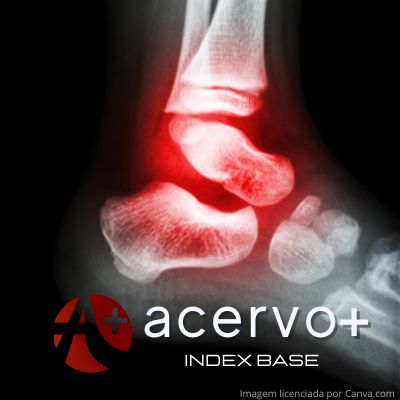Uma análise sobre as características da Artrite Reumatoide: revisão de literatura
##plugins.themes.bootstrap3.article.main##
Resumo
Objetivo: Analisar as características da Artrite Reumatoide (AR). Revisão bibliográfica: A AR acomete cerca de 0,5% e 1% da população mundial, com predomínio de 3 vezes mais no sexo feminino do que no masculino. Os principais sintomas da AR são dor, inflamação, inchaço e rigidez das articulações sinoviais. No entanto, os sintomas de todo o corpo desta doença podem incluir cansaço, temperatura elevada, perda de peso e perda de apetite. A AR tem um forte componente genético, entretanto há fatores de exposição ambiental como exposição a fumaça do tabaco. O tratamento pode ser realizado com Metrotexato, o qual muda a história natural da doença, além de anti-inflamatórios não esteroidais e imunobiológicos. Considerações finais: A AR é uma doença autoimune crônica que afeta as articulações, sendo caracterizada por inflamação simétrica progressiva das articulações afetadas, resultando em destruição da cartilagem, erosão óssea e incapacidade funcional. Podem-se citar também que há manifestações extra articulares como aumento do risco cardiovascular, lesões renais, alterações gastrointestinais e lesões oculares. Nesse sentido, torna-se fundamental o entendimento acerca da doença a fim de propiciar adequado diagnóstico e tratamento.
##plugins.themes.bootstrap3.article.details##
Copyright © | Todos os direitos reservados.
A revista detém os direitos autorais exclusivos de publicação deste artigo nos termos da lei 9610/98.
Reprodução parcial
É livre o uso de partes do texto, figuras e questionário do artigo, sendo obrigatória a citação dos autores e revista.
Reprodução total
É expressamente proibida, devendo ser autorizada pela revista.
Referências
2. ANDRADE TF, DIAS SRC. Etiologia da artrite reumatoide: revisão bibliográfica. Braz. J. Hea. Rev, 2019; 2(4): 3698-718.
3. CAVALCANTE AFS, et al. Gynecological/Obstetric Background and Rheumatoid Arthritis: A Cross-sectional Study in Brazilian Patients. Revista Brasileira de Ginecologia e Obstetrícia; 2021; 43(05): 357-361.
4. CHEBOTAREVA NV, et al. Renal lesions in rheumatoid arthritis: Variants and risk factors. Saudi J Kidney Dis Transpl, 2021 Mar; 32(2): 588-589.
5. CHOY EH, DURES E. Fatigue in rheumatoid arthritis. Rheumatology (Oxford). 2019; 58(5): 1-2.
6. CRAIG E, CAPPELLI LC. Gastrointestinal and Hepatic Disease in Rheumatoid Arthritis. Rheum Dis Clin North Am, 2018; 44(1):89-111.
7. CRAMP F. The role of non-pharmacological interventions in the management of rheumatoid-arthritis-related fatigue. Rheumatology (Oxford), 2019; 58(5): 22-28.
8. ENGLAND BR, et al. Increased cardiovascular risk in rheumatoid arthritis: mechanisms and implications. BMJ, 2018; 361: k1036.
9. GERMANO JL, et al. Prevalência da artrite reumatoide na América do Sul: revisão sistemática e meta-análise. Ciência & Saúde Coletiva, 2021; 26(3): 5371-5382.
10. HUANG J, et al. Promising Therapeutic Targets for Treatment of Rheumatoid Arthritis. Front Immunol. 2021; 12: 686155.
11. HULEN E, et al. Patient goals in rheumatoid arthritis care: A systematic review and qualitative synthesis. Musculoskeletal Care, 2017; 15(4): 295-303.
12. JANG S, et al. Rheumatoid Arthritis: Pathogenic Roles of Diverse Immune Cells. Int J Mol Sci, 2022; 23(2): 905.
13. KRONZER VL, DAVIS JM. Etiologies of Rheumatoid Arthritis: Update on Mucosal, Genetic, and Cellular Pathogenesis. Curr Rheumatol Rep, 2021; 23(4): 21.
14. LIN YJ, et al. Update on the Pathomechanism, Diagnosis, and Treatment Options for Rheumatoid Arthritis. Cells, 2020; 9(4): 880.
15. LOPEZ-PEDRERA C, et al. Effects of Biological Therapies on Molecular Features of Rheumatoid Arthritis. Int J Mol Sci, 2020; 21(23): 9067.
16. MACFARLANE FR, et al. Quantitative Predictive Modelling Approaches to Understanding Rheumatoid Arthritis: A Brief Review. Cells, 2019; 9(1): 74.
17. MEYER PW, et al. Rheumatoid arthritis and risk of cardiovascular disease. Cardiovasc J Afr, 2018; 29(5): 317-321.
18. RIADH EM, et al. Immunologic Parameters for Disease Activity in Rheumatoid Arthritis. Arch Razi Inst, 2021; 76(4):1095-1105.
19. SCHERER HU, et al. The etiology of rheumatoid arthritis. J Autoimmun, 2020; 110:102400.
20. YAN H, et al. Pharmacomicrobiology of Methotrexate in Rheumatoid Arthritis: Gut Microbiome as Predictor of Therapeutic Response. Front Immunol, 2021; 12: 789334.
21. YIP K, NAVARRO-MILLÁN I. Racial, ethnic, and healthcare disparities in rheumatoid arthritis. Curr Opin Rheumatol, 2021; 33(2):117-121.
22. ZHANG A, LEE YC. Mechanisms for Joint Pain in Rheumatoid Arthritis (RA): from Cytokines to Central Sensitization. Curr Osteoporos Rep, 2018; 16(5): 603-610.
23. ZHAO J, et al. Molecular and Cellular Heterogeneity in Rheumatoid Arthritis: Mechanisms and Clinical Implications. Front Immunol, 2021; 12: 790122.
24. ZULFIQAR AA, et al. Rheumatoid arthritis and cardiovascular risk factor: literature review. Rev Med Liege, 2018; 73(12): 634-639.

